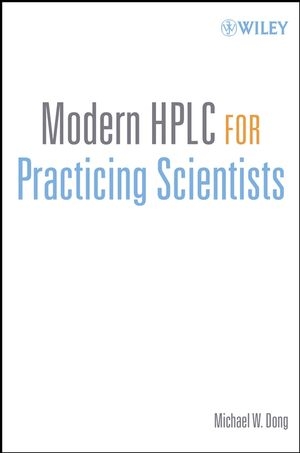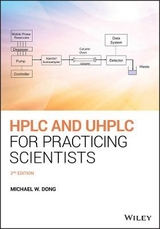
Modern HPLC for Practicing Scientists
Wiley-Blackwell (an imprint of John Wiley & Sons Ltd) (Verlag)
978-0-471-72789-7 (ISBN)
- Titel ist leider vergriffen;
keine Neuauflage - Artikel merken
A comprehesive yet concise guide to Modern HPLC Written for practitioners by a practitioner, Modern HPLC for Practicing Scientists is a concise text which presents the most important High-Performance Liquid Chromatography (HPLC) fundamentals, applications, and developments. It describes basic theory and terminology for the novice, and reviews relevant concepts, best practices, and modern trends for the experienced practitioner. Moreover, the book serves well as an updated reference guide for busy laboratory analysts and researchers. Topics covered include: HPLC operation Method development Maintenance and troubleshooting Modern trends in HPLC such as quick-turnaround and "greener" methods Regulatory aspects While broad in scope, this book focuses particularly on reversed-phase HPLC, the most common separation mode, and on applications for the pharmaceutical industry, the largest user segment. Accessible to both novice and intermedate HPLC users, information is delivered in a straightforward manner illustrated with an abundance of diagrams, chromatograms, tables, and case studies, and supported with selected key references and Web resources.
With intuitive explanations and clear figures, Modern HPLC for Practicing Scientists is an essential resource for practitioners of all levels who need to understand and utilize this versatile analytical technology.
MICHAEL W. DONG, PhD, is a Research Director at Synomics Pharma in Wareham, Massachusetts,responsible for chromatography method development and research studies. He has been a research fellow/group leader at Purdue Pharma, a senior staff scientist at PerkinElmer, and a section head at Hoechst Celanese. He holds a BSc in chemistry from Brooklyn College and a PhD in analytical chemistry from the City University of New York Graduate Center. Dr. Dong pioneered Fast LC and has over eighty publications in chromatography and analytical chemistry. He is the coeditor of another book on pharmaceutical analysis by HPLC, published in 2005.
Preface. 1 Introduction. 1.1 Introduction. 1.1.1 Scope. 1.1.2 What Is HPLC? 1.1.3 A Brief History. 1.1.4 Advantages and Limitations. 1.2 Modes of HPLC. 1.2.1 Normal-Phase Chromatography (NPC). 1.2.2 Reversed-Phase Chromatography (RPC). 1.2.3 Ion-Exchange Chromatography (IEC). 1.2.4 Size-Exclusion Chromatography (SEC). 1.2.5 Other Separation Modes. 1.3 Some Common-Sense Corollaries. 1.4 How to Get More Information. 1.5 Summary. 1.6 References. 2 Basic Terms and Concepts. 2.1 Scope. 2.2 Basic Terms and Concepts. 2.2.1 Retention Time (tR),Void Time (tM), Peak Height (h), and Peak Width (wb). 2.2.2 Retention Volume (VR),Void Volume (VM), and Peak Volume. 2.2.3 Retention Factor (k). 2.2.4 Separation Factor (alpha). 2.2.5 Column Efficiency and Plate Number (N). 2.2.6 Peak Volume. 2.2.7 Height Equivalent to a Theoretical Plate or Plate Height (HETP or H). 2.2.8 Resolution (Rs). 2.2.9 Peak Symmetry: Asymetry Factor (As) and Tailing Factor (Tf). 2.3 Mobile Phase. 2.3.1 General Requirements. 2.3.2 Solvent Strength and Selectivity. 2.3.3 Buffers. 2.3.4 Acidic Mobile Phases. 2.3.5 Ion-Pairing Additives. 2.3.6 High pH Mobile Phase. 2.3.7 Other Operating Parameters: Flow Rate (F) and Column Temperature (T). 2.4 The Resolution Equation. 2.5 The Van Deemter Equation. 2.6 Isocratic vs. Gradient Analysis. 2.6.1 Peak Capacity (n). 2.6.2 Key Gradient Parameters (Initial and Final Solvent Strength, Gradient Time [tG], and Flow Rate). 2.6.3 The 0.25tG Rule:When Is Isocratic Analysis More Appropriate? 2.7 Concept of Orthogonality. 2.8 Sample Capacity. 2.9 Glossary of HPLC Terms. 2.10 Summary and Conclusion. 2.11 References. 3 HPLC Columns and Trends. 3.1 Scope. 3.2 General Column Description and Characteristics. 3.2.1 Column Hardware-Standard vs. Cartridge Format. 3.3 Column Types. 3.3.1 Types Based on Chromatographic Modes. 3.3.2 Types Based on Dimensions. 3.3.3 Column Length (L). 3.4 Column Packing Characteristics. 3.4.1 Support Type. 3.4.2 Particle Size (dp). 3.4.3 Surface Area and Pore Size (dpore). 3.4.4 Bonding Chemistries. 3.4.5 Some General Guidelines for Bonded Phase Selection. 3.5 Modern HPLC Column Trends. 3.5.1 High-Purity Silica. 3.5.2 Hybrid Particles. 3.5.3 Novel Bonding Chemistries. 3.5.4 Fast LC. 3.5.5 Micro LC. 3.5.6 Monoliths. 3.6 Guard Columns. 3.7 Specialty Columns. 3.7.1 Bioseparation Columns. 3.7.2 Chiral Columns. 3.7.3 Application-Specific Columns. 3.8 Column Selection Guides. 3.9 Summary. 3.10 References. 3.11 Internet Resources. 4 HPLC Instrumentation and Trends. 4.1 Introduction. 4.1.1 Scope. 4.1.2 HPLC Systems and Modules. 4.2 HPLC Solvent Delivery Systems. 4.2.1 High-Pressure and Low-Pressure Mixing Designs in Multisolvent Pumps. 4.2.2 System Dwell Volume. 4.2.3 Trends. 4.3 Injectors and Autosamplers. 4.3.1 Operating Principles of Autosamplers. 4.3.2 Performance Characteristics and Trends. 4.4 Detectors. 4.5 UV/VIS Absorbance Detectors. 4.5.1 Operating Principles. 4.5.2 Performance Characteristics. 4.5.3 Trends in Absorbance Detectors. 4.6 Photodiode Array Detectors. 4.6.1 Operating Principles. 4.6.2 Trends in PDA Detectors. 4.7 Other Detectors. 4.7.1 Fluorescence Detector (FLD). 4.7.2 Refractive Index Detector (RID). 4.7.3 Evaporative Light Scattering Detector (ELSD). 4.7.4 Corona-Charged Aerosol Detector (CAD). 4.7.5 Chemiluminescence Nitrogen Detector (CLND). 4.7.6 Electrochemical Detector (ECD). 4.7.7 Conductivity Detector. 4.7.8 Radiometric Detector. 4.8 Hyphenated and Specialized Systems. 4.8.1 LC/MS, LC/MS/MS. 4.8.2 LC/NMR. 4.8.3 Other Hyphenated Systems. 4.8.4 Prep LC and Bio-Purification Systems. 4.8.5 Proteomics Systems: Capillary LC and Multi-Dimensional LC. 4.8.6 High-Throughput Screening (HTS) and Parallel Analysis Systems. 4.8.7 Ultra-High-Pressure Liquid Chromatography. 4.8.8 Lab-on-a-Chip. 4.8.9 Specialized Applications Systems. 4.9 HPLC Accessories and Data Handling Systems. 4.9.1 Solvent Degasser. 4.9.2 Column Oven. 4.9.3 Column Selector Valve. 4.9.4 Data Handling and HPLC Controllers. 4.10 Instrumental Bandwidth (IBW). 4.11 Trends in HPLC Equipment. 4.12 Manufacturers and Equipment Selection. 4.13 Summary. 4.14 References. 4.15 Internet Resources. 5 HPLC Operation Guide. 5.1 Scope. 5.2 Safety and Environmental Concerns. 5.2.1 Safety Concerns. 5.2.2 Environmental Concerns. 5.3 Mobile Phase Preparation. 5.3.1 Mobile Phase Premixing. 5.3.2 Buffers. 5.3.3 Filtration. 5.3.4 Degassing. 5.4 Best Practices in HPLC System Operation. 5.4.1 Pump Operation. 5.4.2 HPLC Column Use, Connection, and Maintenance. 5.4.2.1 Column Use. 5.4.2.2 Column Precautions. 5.4.2.3 Column Connection. 5.4.2.4 Column Maintenance and Regeneration. 5.4.3 Autosampler Operation. 5.4.4 Detector Operation. 5.4.5 System Shutdown. 5.4.6 Guidelines for Increasing HPLC Precision. 5.4.6.1 Guidelines for Improving Retention Time Precision. 5.4.6.2 Guidelines for Improving Peak Area Precision. 5.5 From Chromatograms to Reports. 5.5.1 Qualitative Analysis Strategies. 5.5.2 Quantitation Analysis Strategies. 5.6 Summary of HPLC Operation. 5.7 Guides on Performing Trace Analysis. 5.8 Summary. 5.9 References. 6 Pharmaceutical Analysis. 6.1 Introduction. 6.1.1 Scope. 6.1.2 Overview: From Drug Discovery to Quality Control. 6.1.3 Sample Preparation Perspectives in Drug Product Analysis. 6.1.4 High-Throughput LC/MS in Drug Discovery Support. 6.2 Identification. 6.3 Assays. 6.3.1 Drug Substances. 6.3.2 Drug Products. 6.3.3 Content Uniformity. 6.3.4 Products with Multiple APIs and Natural Products. 6.3.5 Assay of Preservatives. 6.4 Impurity Testing. 6.4.1 Trends in Impurity Testing. 6.5 Dissolution Testing. 6.6 Cleaning Validation. 6.7 Bioanalytical Testing. 6.8 Chiral Analysis. 6.9 Case Study: HPLC Methods in Early Development. 6.10 Summary. 6.11 References. 7 Food, Environmental, Chemical, and Life Sciences Applications. 7.1 Introduction. 7.1.1 Scope. 7.2 Food Applications. 7.2.1 Natural Food Components. 7.2.1.1 Sugars. 7.2.1.2 Fats, Oils, and Triglycerides. 7.2.1.3 Free Fatty Acids and Organic Acids. 7.2.1.4 Proteins and Amino Acids. 7.2.2 Food Additives. 7.2.2.1 Flavors: A Case Study on HPLC Analysis of Capsaicins. 7.2.3 Contaminants. 7.2.3.1 Mycotoxins. 7.2.3.2 Antimicrobial Additives. 7.2.3.3 Pesticide Residues. 7.3 Environmental Applications. 7.3.1 Listing of Important U.S. EPA HPLC Methods. 7.3.2 Pesticides Analysis. 7.3.2.1 Carbamates and Glyphosate. 7.3.3 Polynuclear Aromatic Hydrocarbons (PAH). 7.3.3.1 Case Study: Quick Turnaround Analysis of PAHs by HPLC in Multimedia Samples. 7.4 Chemical, GPC and Plastics Applications. 7.4.1 Gel-Permeation Chromatography (GPC) and Analysis of Plastics Additives. 7.5 Ion Chromatography. 7.6 Life Sciences Applications. 7.6.1 Proteins, Peptides, and Amino Acids. 7.6.2 Bases, Nucleosides, Nucleotides, Oligonucleotides, Nucleic Acids, and PCR Products. 7.7 Summary. 7.8 References. 8 HPLC Method Development. 8.1 Introduction. 8.1.1 Scope. 8.1.2 Considerations Before Method Development. 8.1.3 Strategy for Method Development. 8.1.4 HPLC Method Development Trends in Pharmaceutical Analysis. 8.2 Defining Method Types and Goals. 8.2.1 Method Goals. 8.3 Gathering Sample and Analyte Information. 8.3.1 Defining Sample Preparation Requirements. 8.4 Initial HPLC Method Development. 8.4.1 Initial Detector Selection. 8.4.2 Selection of Chromatographic Mode. 8.4.3 Initial Selection of HPLC Column. 8.4.4 Generating a First Chromatogram. 8.4.4.1 Case Study: Initial Method Development Using a Broad Gradient and Mobile Phase Selection. 8.5 Method Fine-Tuning. 8.5.1 Mobile Phase Parameters (%B, Buffer, pH, Solvent Type). 8.5.2 Operating Parameters (F, T, phi, tG). 8.5.3 Column Parameters (Bonded Phase Type, L, dp, dc). 8.5.4 Detector Setting and Sample Amount. 8.5.5 Summary of Method Development Steps. 8.6 Phase-Appropriate Method Development. 8.7 Method Development Software Tools. 8.8 Case Studies. 8.8.1 Composite Assay Method for a Neutral Drug Substance. 8.8.2 Composite Drug Substance Method for a Basic Drug Substance. 8.8.3 Impurity Method for a Drug Product with Two APIs. 8.9 Summary and Conclusions. 8.10 References. 9 Regulatory Aspects of HPLC Analysis: HPLC System and Method Validation. 9.1 Introduction. 9.1.1 Scope. 9.1.2 The Regulatory Environment. 9.2 HPLC System Qualification. 9.2.1 Design Qualification (DQ). 9.2.2 Installation Qualification (IQ). 9.2.3 Operational Qualification (OQ). 9.2.4 Performance Qualification (PQ). 9.2.5 Documentation. 9.2.6 System Calibration. 9.3 Method Validation. 9.3.1 Validation Parameters. 9.4 System Suitability Testing (SST). 9.5 Case Study on Method Validation. 9.6 Cost-Effective Regulatory Compliance. 9.7 Summary and Conclusions. 9.8 References. 9.9 Internet Resources. 10 HPLC Maintenance and Troubleshooting Guide. 10.1 Scope. 10.2 HPLC System Maintenance. 10.2.1 LC Pump. 10.2.2 UV/Vis Detectors. 10.2.3 Injector and Autosampler. 10.3 HPLC Troubleshooting. 10.3.1 General Problem Diagnostic and Troubleshooting Guide. 10.3.2 Common HPLC Problems. 10.3.2.1 Pressure Problems and Causes. 10.3.2.2 Baseline Problems (Chromatogram). 10.3.2.3 Peak Problems (Chromatogram). 10.3.2.4 Data Performance Problems. 10.4 Case Studies. 10.4.1 Case Study 1: Reducing Baseline Shift and Noise for Gradient Analysis. 10.4.2 Case Study 2: Poor Peak Area Precision Encountered During HPLC System Calibration. 10.4.3 Case Study 3: Poor Assay Accuracy Data, an Out-of- Specification Investigation. 10.4.4 Case Study 4: Equipment Malfunctioning. 10.5 Summary and Conclusion. 10.6 References. 10.7 Internet Resources. 11 Modern Trends in HPLC. 11.1 Columns: Shorter and Narrower Packed with Small Particles. 11.2 Column Packing: Novel Bonded Phases. 11.3 Pumps. 11.4 Autosamplers. 11.5 Detectors. 11.6 HPLC Systems. 11.6.1 Low-Dispersion Instruments. 11.6.2 Ultra-High-Pressure LC. 11.6.3 Multi-Dimensional LC. 11.6.4 Parallel Analysis. 11.7 Lab-on-a-Chip. 11.8 Data Handling. 11.9 Regulatory Compliance. 11.10 Greener HPLC Methods. 11.11 Summary and Conclusions. 11.12 References. Index.
| Erscheint lt. Verlag | 11.7.2006 |
|---|---|
| Verlagsort | Chichester |
| Sprache | englisch |
| Maße | 166 x 238 mm |
| Gewicht | 470 g |
| Themenwelt | Naturwissenschaften ► Chemie ► Analytische Chemie |
| ISBN-10 | 0-471-72789-X / 047172789X |
| ISBN-13 | 978-0-471-72789-7 / 9780471727897 |
| Zustand | Neuware |
| Haben Sie eine Frage zum Produkt? |
aus dem Bereich



